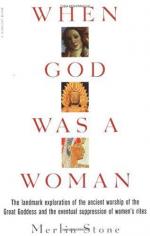|
This section contains 1,247 words (approx. 4 pages at 400 words per page) |

|
Chapter 6 Summary and Analysis
In the Neolithic and earliest historic periods, female monarchs/high priestesses rule divinely, appointed by female divinities with males attaining power only through marriage. Temples are the core of communities, whence not only religious business, but all urban and rural activities are directed. Entu is the name of the high priestess in Sumer, Tawawannas in Anatolia; other locales have counterparts for their "Divine Lady". Early Sumerian myths show male and female deities taking part in heavenly decision making, probably reflecting the societies that write the legends. Monotheism reflects a political ideology in which a single person rules, while polytheism images the communal attitude. There is no definite evidence for a relationship between the high priestess' role and the groups of elders.
The priestess, an incarnation of the Goddess, takes not a permanent husband, but rather annual lovers or consorts over whom...
(read more from the Chapter 6 Summary)
|
This section contains 1,247 words (approx. 4 pages at 400 words per page) |

|




